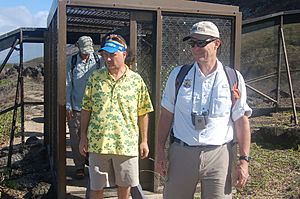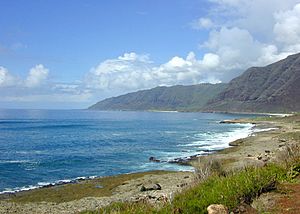Kaena Point facts for kids
Kaʻena Point is the very western tip of the island of Oʻahu in Hawaii. It's a special place that you can only reach by walking. You can start your walk from either the North Shore (near Mokulēʻia) or the Waiʻanae Coast. Cars can't go all the way to the point because the path becomes very narrow and rocky.
In the Hawaiian language, kaʻena means 'the heat'. This area was named after a relative of Pele, the Hawaiian goddess of volcanoes. The State of Hawaiʻi has made Kaʻena Point a Natural Area Reserve. This means it's a protected place. It helps keep important animals safe, like Laysan Albatrosses and Wedge-tailed Shearwaters (types of seabirds), and Hawaiian monk seals. It also protects the special plants that grow there.
Some old Hawaiian stories say that Kaʻena Point is where souls leave this world. It's seen as a spiritual place.
Contents
Nature at Kaʻena Point
Kaʻena Point is home to many unique plants and animals. They are all part of a special ecosystem found only in Hawaii.
Plants of Kaʻena
Many native Hawaiian plants grow here. They are adapted to the dry, windy conditions.
- ‘ohai (Sesbania tomentosa)
- naupaka kahakai (Scaevola sericea)
- ‘ilima papa (Sida falax)
- naio (Myoporum sandwicense)
- pa‘u-o-Hi‘iaka (Jacquemontia ovalifolia)
- ma‘o - Hawaiian cotton (Gossypium tomentosum)
- Ka‘ena ‘akoko (Chamaesyce celastroides var. kaenana)
- hinahina (Heliotropium anomulum)
- pohinahina (Vitex rotundifolia)
- nehe (Lipochaeta integrifolia)
Animals of Kaʻena
This area is a safe haven for several important animal species.
- Hawaiian Monk Seal (Monachus schauislandi)
- Moli (Laysan Albatross) (Diomedia immutabilis)
- Yellow Faced Bees (Hylaeus longiceps)
Things to Do at Kaʻena Point
Kaʻena Point is a great place for hiking and enjoying nature. It's also known for snorkeling in certain areas. The beach here has white sand and stretches towards the Waianae Mountains. You can see many different kinds of fish while snorkeling, including Hawaii's State Fish, the Humuhumunukunukuapuaa.
Surfing at Kaʻena
During the winter, Oʻahu's North Shore gets huge waves. These waves attract surfers from all over the world. Some people say that Kaʻena Point can have waves even bigger than those at Waimea Bay. Waimea Bay is one of Oʻahu's most famous surfing spots.
In 1969, a famous surfer named Greg Noll took a picture of a giant wave breaking at Kaʻena Point. Later, in 1998, professional surfer Ken Bradshaw was photographed riding a wave that was said to be 85 feet (26 meters) tall. People also reported seeing waves 60 to 80 feet (18 to 24 meters) tall at Kaʻena Point during that time.
Even with these huge waves, Kaʻena Point is not a popular surfing spot. It's very remote, meaning there are no paved roads to get there. Also, there are no rescue teams nearby. The ocean conditions here can be very dangerous, with strong undertows and rip currents. This makes water activities very risky.
Kaʻena's Volcanic Past
Kaʻena was once an active shield volcano. It formed about 15% of the island of Oʻahu. It is also the oldest volcano on Oʻahu, being about 5 million years old. When it stopped being active about 4.2 million years ago, it was about 3,000 feet (914 meters) tall.
Protecting Kaʻena Point

In 2011, a special fence was built at Kaʻena Point. It was the first "predator proof" fence in the United States. This fence cost about $290,000 to build. It is about 2,133 feet (650 meters) long and protects 59 acres of land.
Some people thought the fence made the area less beautiful. However, the fence has been very helpful. It keeps animals like rats, cats, and mongoose out of the protected area. These animals can harm native birds and plants. Since the fence was built, the number of Wedge-tailed Shearwater and Laysan Albatross chicks has grown a lot. Many native plants, like Ohia and Sandalwood trees, have also increased. This shows the fence is helping to protect Kaʻena Point's special wildlife.




